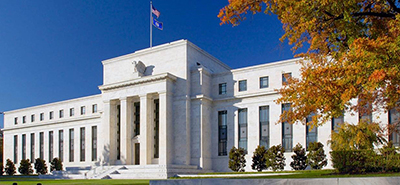
FOMC Pushes Up Rate Hike Schedule

The Federal Reserve isn’t planning on raising key interest rates any time soon, but the trigger finger appears to be getting itchier.
The Federal Open Market Committee statement following the end of its two-day policy meeting Wednesday keeps the federal funds rate at 0-0.25 percent—where it’s been since March 2020, at the onset of the full effects of the coronavirus pandemic. But analysts, including Mike Fratantoni, Chief Economist with the Mortgage Bankers Association, said language in the FOMC statement suggests members could move a rate hike up in the schedule.
“The biggest news out of this meeting was the change in FOMC projections, with most members now seeing a first interest rate hike in 2022, which is faster than many market participants had previously anticipated,” Fratantoni said.
The other news coming out of the meeting: the FOMC hinted it is ready to “taper” its purchase of securities. Currently the Federal Reserve has been increasing its holdings of Treasury securities by at least $80 billion per month and its holdings of agency mortgage-backed securities by at least $40 million per month. Last December, the FOMC said it would continue to do so until “substantial further progress” has been made toward its maximum employment and price stability goals.
“Since then, the economy has made progress toward these goals,” the FOMC said. “If progress continues broadly as expected, the Committee judges that a moderation in the pace of asset purchases may soon be warranted.”
“To paraphrase Chekov, if at the September meeting the Fed lays out a tapering plan, they must use it in November,” Fratantoni said. “There would need to be a significant negative surprise in the incoming data for them to delay. The job market has improved, inflation is running hot and supply chain constraints are persisting. As a result, it is not surprising that the Fed will begin to remove accommodation.”
For the mortgage market, Fratantoni said the pending taper and change to the monetary policy outlook will likely contribute to a modest increase in mortgage rates over the medium term.
“The biggest challenge to the housing market continues to be the lack of supply, hindered by the same supply chain constraints that are impacting the broader economy,” Fratantoni said. “MBA is forecasting growth in home sales and purchase mortgage originations for next year and beyond, but does expect a sharp decline in refinance volumes.”
The full FOMC statement appears below:
“The Federal Reserve is committed to using its full range of tools to support the U.S. economy in this challenging time, thereby promoting its maximum employment and price stability goals.
“With progress on vaccinations and strong policy support, indicators of economic activity and employment have continued to strengthen. The sectors most adversely affected by the pandemic have improved in recent months, but the rise in COVID-19 cases has slowed their recovery. Inflation is elevated, largely reflecting transitory factors. Overall financial conditions remain accommodative, in part reflecting policy measures to support the economy and the flow of credit to U.S. households and businesses.
“The path of the economy continues to depend on the course of the virus. Progress on vaccinations will likely continue to reduce the effects of the public health crisis on the economy, but risks to the economic outlook remain.
“The Committee seeks to achieve maximum employment and inflation at the rate of 2 percent over the longer run. With inflation having run persistently below this longer-run goal, the Committee will aim to achieve inflation moderately above 2 percent for some time so that inflation averages 2 percent over time and longer‑term inflation expectations remain well anchored at 2 percent. The Committee expects to maintain an accommodative stance of monetary policy until these outcomes are achieved. The Committee decided to keep the target range for the federal funds rate at 0 to 1/4 percent and expects it will be appropriate to maintain this target range until labor market conditions have reached levels consistent with the Committee’s assessments of maximum employment and inflation has risen to 2 percent and is on track to moderately exceed 2 percent for some time.
“Last December, the Committee indicated that it would continue to increase its holdings of Treasury securities by at least $80 billion per month and of agency mortgage‑backed securities by at least $40 billion per month until substantial further progress has been made toward its maximum employment and price stability goals. Since then, the economy has made progress toward these goals. If progress continues broadly as expected, the Committee judges that a moderation in the pace of asset purchases may soon be warranted. These asset purchases help foster smooth market functioning and accommodative financial conditions, thereby supporting the flow of credit to households and businesses.
“In assessing the appropriate stance of monetary policy, the Committee will continue to monitor the implications of incoming information for the economic outlook. The Committee would be prepared to adjust the stance of monetary policy as appropriate if risks emerge that could impede the attainment of the Committee’s goals. The Committee’s assessments will take into account a wide range of information, including readings on public health, labor market conditions, inflation pressures and inflation expectations, and financial and international developments.
“Voting for the monetary policy action were Jerome H. Powell, Chair; John C. Williams, Vice Chair; Thomas I. Barkin; Raphael W. Bostic; Michelle W. Bowman; Lael Brainard; Richard H. Clarida; Mary C. Daly; Charles L. Evans; Randal K. Quarles; and Christopher J. Waller.”
